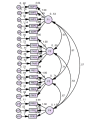Influence of Social Media Platforms on Public Health Protection Against the COVID-19 Pandemic via the Mediating Effects of Public Health Awareness and Behavioral Changes: Integrated Model
- PMID: 32750004
- PMCID: PMC7439806
- DOI: 10.2196/19996
Influence of Social Media Platforms on Public Health Protection Against the COVID-19 Pandemic via the Mediating Effects of Public Health Awareness and Behavioral Changes: Integrated Model
Abstract
Background: Despite the growing body of literature examining social media in health contexts, including public health communication, promotion, and surveillance, limited insight has been provided into how the utility of social media may vary depending on the particular public health objectives governing an intervention. For example, the extent to which social media platforms contribute to enhancing public health awareness and prevention during epidemic disease transmission is currently unknown. Doubtlessly, coronavirus disease (COVID-19) represents a great challenge at the global level, aggressively affecting large cities and public gatherings and thereby having substantial impacts on many health care systems worldwide as a result of its rapid spread. Each country has its capacity and reacts according to its perception of threat, economy, health care policy, and the health care system structure. Furthermore, we noted a lack of research focusing on the role of social media campaigns in public health awareness and public protection against the COVID-19 pandemic in Jordan as a developing country.
Objective: The purpose of this study was to examine the influence of social media platforms on public health protection against the COVID-19 pandemic via public health awareness and public health behavioral changes as mediating factors in Jordan.
Methods: A quantitative approach and several social media platforms were used to collect data via web questionnaires in Jordan, and a total of 2555 social media users were sampled. This study used structural equation modeling to analyze and verify the study variables.
Results: The main findings revealed that the use of social media platforms had a significant positive influence on public health protection against COVID-19 as a pandemic. Public health awareness and public health behavioral changes significantly acted as partial mediators in this relationship. Therefore, a better understanding of the effects of the use of social media interventions on public health protection against COVID-19 while taking public health awareness and behavioral changes into account as mediators should be helpful when developing any health promotion strategy plan.
Conclusions: Our findings suggest that the use of social media platforms can positively influence awareness of public health behavioral changes and public protection against COVID-19. Public health authorities may use social media platforms as an effective tool to increase public health awareness through dissemination of brief messages to targeted populations. However, more research is needed to validate how social media channels can be used to improve health knowledge and adoption of healthy behaviors in a cross-cultural context.
Keywords: COVID-19; Interventions; Jordan; awareness; behavior; behavioral change; coronavirus; pandemic; public health; public health protection; social media; social media platforms.
©Hani Al-Dmour, Ra’ed Masa’deh, Amer Salman, Mohammad Abuhashesh, Rand Al-Dmour. Originally published in the Journal of Medical Internet Research (http://www.jmir.org), 19.08.2020.
Conflict of interest statement
Conflicts of Interest: None declared.
Figures
References
-
- Velasco E, Agheneza T, Denecke K, Kirchner G, Eckmanns T. Social media and internet-based data in global systems for public health surveillance: a systematic review. Milbank Q. 2014 Mar 06;92(1):7–33. doi: 10.1111/1468-0009.12038. http://europepmc.org/abstract/MED/24597553 - DOI - PMC - PubMed
-
- Giustini DM, Ali SM, Fraser M, Kamel Boulos MN. Effective uses of social media in public health and medicine: a systematic review of systematic reviews. Online J Public Health Inform. 2018 Sep 21;10(2):e215. doi: 10.5210/ojphi.v10i2.8270. http://europepmc.org/abstract/MED/30349633 - DOI - PMC - PubMed
-
- Chan JF, Yuan S, Kok K, To KK, Chu H, Yang J, Xing F, Liu J, Yip CC, Poon RW, Tsoi H, Lo SK, Chan K, Poon VK, Chan W, Ip JD, Cai J, Cheng VC, Chen H, Hui CK, Yuen K. A familial cluster of pneumonia associated with the 2019 novel coronavirus indicating person-to-person transmission: a study of a family cluster. Lancet. 2020 Feb;395(10223):514–523. doi: 10.1016/s0140-6736(20)30154-9. - DOI - PMC - PubMed
-
- Epidemiological situation. Website in Arabic. Jordanian Ministry of Health. [2020-08-12]. https://corona.moh.gov.jo/ar.
MeSH terms
LinkOut - more resources
Full Text Sources




